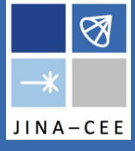Donald Clayton (Clemson University, USA)
"At the Crossroad"
Most begin following a specific research road because it is where one wants to work; but unexpected opportunity tempts one to uncharted paths, which is scary because of what one would give up. My own research life took several new crossroads despite the anxiety each presents. I was very fortunate that my own development paralleled that of nucleosynthesis, which I carried onto each crossroad. They were:
(1) nuclear astrophysics instead of laboratory nuclear physics; (2) job at Rice University’s new Space Physics Department, and my textbook Principles of Stellar Evolution and Nucleosynthesis; (3) return to Caltech to discover Silicon-burning Quasiequilibrium; (4) annual position for five-years in Cambridge U.K. at Fred Hoyle’s new 5-yr Institute of Theoretical Astronomy; (5) personal evolution owing to a five-decade love affair with England; (6) Clayton, Colgate and Fishman (ApJ 1969) and gamma-ray-line astronomy; (7) Compton Gamma-Ray Observatory (1977-2005); (8) heresy of supernova stardust (1975-2000); (9) theory of carbon condensation in hot oxygen-rich gas in supernovae (1975-2010); (10) History of science: photo archive; autobiography; Fred Hoyle and B2FH; editing Wikipedia.
Several paths took breathtaking risks resulting successfully in new theory. Each of us faces similar possibilities for change; and deciding whether to turn is hard.
Volker Bromm (University of Texas, Austin, USA)
"How was the Universe enriched with the first heavy chemical elements?"
The emergence of the first stars fundamentally transformed the early universe, as sources for high-energy radiation and the first heavy chemical elements. I will review our current understanding of how the first supernovae enriched the pristine intergalactic gas, how the metals were transported into the surrounding medium, and how they eventually enabled the formation of long-lived, metal-poor stars. I will conclude with a discussion of stellar archaeology, the increasingly high-precision endeavor to constrain the properties of the first stars with large surveys of metal-poor stars in the Milky Way and in dwarf galaxies within the Local Group.
Kelly Chipps (Oak Ridge National Laboratory, USA)
"Novel Methods for Studying Nucleosynthesis in the lab"
In the field of nuclear astrophysics, it pays to be creative. While direct measurements of astrophysically important reaction cross sections are still the ideal method for studying nucleosynthesis, often such direct measurements are not feasible with existing beam intensities and detection systems. This talk will highlight some unique ways of studying nucleosynthesis indirectly.
Alex Zylstra (Los Alamos National Laboratory, USA)
“Studying nuclear astrophysics with laser-generated high-energy-density plasmas”
Plasmas generated by laser-fusion experiments, such as OMEGA and the National Ignition Facility, are a unique platform for nuclear astrophysics studies, including cross-section measurements. Recent work on several big-bang and stellar relevant reactions will be discussed, plus opportunities for unique future experiments.
Micha Kilburn and Nancy Michael ( University of Notre Dame, USA)
"Blinded to Excellence"
Vinicius Placco (University of Notre Dame, USA)
"Observational constraints on the origin of the elements: from First stars to Neutron-Star mergers"
Long-lived low-mass stars hold the key to understand how the Universe evolved chemically from hydrogen and helium to the myriad of abundance patterns we observe in stars today. In particular, extremely metal-poor stars (EMP - [Fe/H]<-3) are believed to be the only survivors of a time when the Universe was still in its early stages of chemical evolution. In this talk, I will review some of the observational evidence that connects EMP stars observed today to very specific astrophysical events (such as faint Supernovae explosions and Neutron-star mergers) that occurred more than 12 billion years in the past. I will also introduce current (and future) observational efforts aiming to increase the inventory of known low-metallicity stars, which will help constrain theoretical models of the evolution of our Galaxy and the Universe.
Arthur Choplin (Geneva Observatory & University of Geneva, Switzerland)
"Nucleosynthesis in Rotating massive stars and Abundances of metal-poor stars."
Axial rotation largely impacts the nucleosynthesis in low-metallicity massive stars. We review the effects of rotation at low-metallicity and discuss how low-mass metal-poor stars of our Galaxy can constrain the early massive stellar generation.
Marco Pignatari (University of Hull, United Kingdom)
"Neutron capture processes at work in stars: a nuclear astrophysics boot camp"
There are still many puzzles that need to be solved concerning the production of heavy elements in stars by neutron-capture processes. Sometimes new results are even questioning previous established scenarios. Nuclear astrophysics plays a crucial role in moving forward our knowledge in this field of research.
I will discuss few examples from different abundance observations, carrying the signature of the s-process, the i-process, the n-process and the r-process.
Kelly Patton (University of Washington, Seattle, USA)
"Neutrinos from Beta Processes in Presupernovae"
The study of neutrinos from the collapse of massive stars, and the potential signals in detectors, has a rich history. Relatively unstudied, however, are the neutrinos produced in the lead up to core collapse. The importance of beta processes on neutrino emission in late stage stellar evolution will be discussed, as well as the potential for observation of such a signal.
Rebecca Surman (University of Notre Dame, USA)
"Nuclear physics and r-process nucleosynthesis in the multi-messenger era."
The electromagnetic counterpart of the GW170817 neutron star merger provided the first direct evidence of the astrophysical formation of nuclei via rapid neutron capture (r-process) nucleosynthesis. Full understanding of this event from first principles and its role in galactic chemical evolution requires progress in a number of areas. One key area is nuclear physics. A neutron star merger r-process involves thousands of exotic nuclear species, the majority of which have never been studied in the laboratory. Here we will discuss r-process nuclear data needs and how nuclear physics uncertainties influence our interpretation of observed abundance patterns and kilonova signals. We will explore the promise of experimental campaigns at rare isotope beam facilities to reduce these uncertainties, and describe recent efforts to directly connect nuclear data to astrophysical environments via the ‘reverse-engineering’ of unknown nuclear properties from the r-process abundance pattern.
